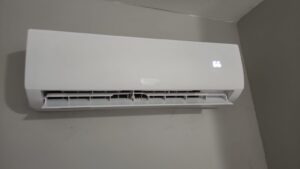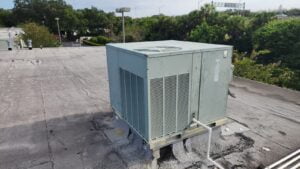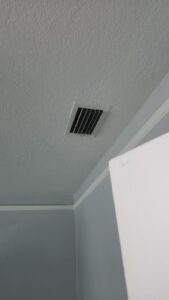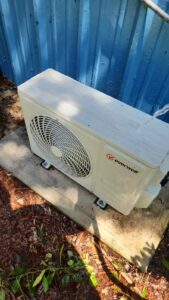Ductless Mini Split vs. Central AC
Selecting the ideal cooling system for your home is a significant decision. Ductless Mini Split and Central Air Conditioning (AC) systems are two popular options, each with its set of advantages and disadvantages. This comprehensive analysis will explore 10 key pros and cons associated with both systems, empowering you to make an informed choice.
Ductless Mini Split Systems
Ductless Mini Split Pros:
- Energy Efficiency: Ductless mini-split systems are renowned for their energy efficiency. With high SEER (Seasonal Energy Efficiency Ratio) ratings, they can provide substantial energy savings, reducing your utility bills.
- Zone Control: One of the standout features of ductless systems is their ability to offer precise zone control. You can set different temperatures for individual rooms or zones, allowing for customized comfort throughout your home.
- Easy Installation: Installing a ductless mini-split is relatively straightforward compared to central AC systems. It doesn’t require ductwork, making it a flexible choice for both new construction and retrofitting older homes.
- Aesthetics: The indoor units of the ductless mini split are compact and sleek, minimizing their visual impact in your living spaces. They can be mounted on walls or ceilings discreetly.
- Quiet Operation: Ductless mini-split systems operate quietly, ensuring a peaceful and undisturbed indoor environment.
Ductless Mini Split Cons:
- Initial Cost: While ductless mini-splits offer long-term savings, their upfront costs can be higher than some central AC systems. However, these costs can vary depending on factors like the number of indoor units required.
- Limited Coverage: Ductless systems are well-suited for smaller to medium-sized homes. In larger homes, installing multiple units for comprehensive coverage might become cost-prohibitive.
- Maintenance Considerations: While maintenance requirements are generally straightforward, the need for periodic cleaning and filter replacement should be noted.

Central Air Conditioning Systems
Central AC Pros:
- Uniform Cooling: Central AC systems excel at providing even cooling throughout your entire home. They maintain a consistent temperature in every room.
- Lower Initial Cost: Compared to some ductless mini-splits, central AC systems often have lower upfront installation costs.
- Simplified Maintenance: Central AC units are typically easier to maintain since all components are located in one place, usually outdoors.
- Compatibility with Ducts: If your home already has ductwork, central AC systems can leverage this infrastructure, potentially reducing installation expenses.
Central AC Cons:
- Energy Efficiency Challenges: Older central AC systems may lack the energy efficiency of newer models or ductless mini-splits. This can result in higher long-term operating costs.
- Zoning Limitations: Achieving precise temperature control in individual rooms can be challenging with central AC. Zoning solutions may require additional investments, such as smart thermostats and dampers.
- Aesthetic Impact: Central AC systems often involve visible ductwork and vents, which can affect the aesthetics of your home.
- Noise Levels: Depending on the unit’s size and location, central AC systems can generate noise, potentially disrupting the peace and quiet in your home.

Energy Efficiency and Environmental Impact
Ductless mini-splits tend to have higher SEER and EER ratings compared to central AC systems. This means they operate more efficiently, consuming less energy. As a result, they not only save you money but also have a lower environmental impact by reducing greenhouse gas emissions.
Installation, Maintenance, and Lifespan
When it comes to the installation, maintenance, and lifespan of Ductless Mini Split and Central AC systems, there are significant differences that can impact your decision-making process.
Installation:
Ductless Mini Split Systems:
Installing the ductless mini split system is generally more straightforward compared to central AC systems. Here’s what you can expect:
- No Ductwork Required: One of the primary advantages of a ductless mini split is that they don’t require ductwork. This makes installation faster and less invasive to your home’s structure.
- Placement Flexibility: The indoor units of a ductless mini split can be mounted on walls, ceilings, or even recessed into the ceiling. This flexibility allows for precise placement to maximize cooling efficiency and aesthetics.
- Minimal Construction: Since no ductwork is needed, you won’t have to deal with the construction and retrofitting often required for central AC systems.
Central AC Systems:
Installing central AC systems can be more complex and might involve the following considerations:
- Ductwork Requirements: If your home doesn’t already have ductwork in place, installing it can be a significant undertaking, both in terms of time and cost.
- Ductwork Modification: In older homes, existing ductwork might need repairs or modifications to accommodate the new central AC system.
- Outdoor Unit Placement: Central AC systems require an outdoor condenser unit, which must be properly placed and connected to the indoor unit.
Maintenance:
Ductless Mini Split Systems:
Maintenance for ductless mini split systems is relatively straightforward:
- Regular Cleaning: Cleaning the filters and indoor units periodically is essential to maintain optimal performance and indoor air quality.
- Occasional Professional Service: While you can handle basic maintenance tasks, it’s advisable to have a professional inspect and service the system annually to ensure it continues to operate efficiently.
Central AC Systems:
Maintenance for central AC systems might involve:
- Duct Cleaning: Ducts can accumulate dust and debris over time, affecting indoor air quality and system efficiency. Periodic duct cleaning may be necessary.
- Regular Servicing: Central AC systems should be professionally serviced annually. This includes checking refrigerant levels, cleaning coils, and ensuring all components are in working order.
- Filter Replacement: Like ductless mini split, central AC systems require regular filter replacement to maintain airflow and system efficiency.
Lifespan:
The lifespan of both Ductless Mini-Split and Central Air Conditioning (AC) systems can vary depending on several factors, including the quality of the system, maintenance practices, and usage. However, on average, you can expect the following lifespans for these systems:
Ductless Mini-Split Systems:
Ductless mini-split systems are known for their durability and can have a relatively long lifespan. On average, you can expect a well-maintained ductless mini-split system to last between 15 to 20 years or more. Here are some factors that can influence the lifespan:
- Quality of Installation: Proper installation by a qualified HVAC technician is essential for the long-term performance of a ductless mini-split system. Poorly installed systems may not last as long.
- Maintenance: Regular maintenance, including cleaning filters and ensuring all components are in good working order, can extend the lifespan of the system.
- Usage: The frequency of use and the demands placed on the system can affect its longevity. Systems used year-round may have a shorter lifespan compared to those used seasonally.
- Brand and Model: The quality and reputation of the brand and model you choose can impact how long the system lasts. High-quality systems from reputable manufacturers tend to have longer lifespans.
Central Air Conditioning Systems:
Central AC systems also have a similar average lifespan of approximately 15 to 20 years when well-maintained. However, there are factors to consider:
- Quality of Installation: Proper installation by a qualified HVAC technician is critical for the performance and longevity of central AC systems.
- Maintenance: Regular maintenance, including cleaning coils, checking refrigerant levels, and inspecting all components, is essential for extending the lifespan.
- Ductwork: The condition of your home’s ductwork can also impact the longevity of a central AC system. Well-maintained ducts contribute to the efficiency and effectiveness of the system.
- Usage: As with mini-splits, how often the central AC system is used and the demands placed on it can affect how long it lasts.
- Brand and Model: The quality of the central AC unit you choose, along with the manufacturer’s reputation, can influence its lifespan.
It’s important to note that these are average lifespans, and individual experiences may vary. Regular maintenance and proper care can significantly extend the life of both ductless mini-split and central AC systems. Additionally, if you are considering a replacement, it’s advisable to consult with an HVAC professional who can assess your system’s condition and provide recommendations based on your specific situation.

Zoning, Aesthetics, and Noise Levels
When evaluating Ductless Mini Split and Central AC systems, factors like zoning, aesthetics, and noise levels play a crucial role in determining which system aligns better with your comfort and home design preferences.
Zoning and Temperature Control:
Ductless Mini Split Systems:
Ductless mini-split systems excel in providing zoning and temperature control:
- Precise Zoning: One of the standout features of ductless mini-splits is their ability to offer precise zone control. Each indoor unit is a separate zone that can be controlled independently. This means you can customize the temperature in different rooms or areas of your home according to individual preferences.
- Variable Speed Compressors: Ductless systems often come equipped with variable speed compressors, allowing for fine-tuned temperature adjustments and energy-efficient operation.
Central AC Systems:
Central AC systems can achieve zoning, but it might require additional components and considerations:
- Smart Thermostats: To achieve zoning with central AC, you might need to invest in smart thermostats that can control specific zones or areas. These thermostats can be programmed to adjust temperatures according to your preferences.
- Dampers: Some central AC systems use dampers within the ductwork to control airflow to different zones. This adds complexity to the system but allows for zoning.
Aesthetics and Noise Levels:
Ductless Mini Split Systems:
Ductless mini-splits are designed with aesthetics in mind:
- Compact Indoor Units: The indoor units of ductless mini-splits are typically sleek and compact. They can be wall-mounted or ceiling-recessed, minimizing their visual impact on your interior spaces.
- Quiet Operation: Ductless mini-split systems are known for their quiet operation. Both the indoor and outdoor units generate minimal noise, providing a comfortable and peaceful indoor environment.
Central AC Systems:
Central AC systems can have different considerations for aesthetics and noise levels:
- Visible Ductwork: Central AC systems often involve visible ductwork and vents. This can impact the aesthetics of your home, especially if you have a preference for a clean and uncluttered interior.
- Noise Levels: The noise generated by central AC systems can vary depending on factors like the unit’s size and location. While modern units are designed to be quieter, noise can still be a concern, particularly if the unit is near a bedroom or living area.
When it comes to zoning, ductless mini-split systems offer a superior advantage with precise and individualized temperature control for various areas of your home. In terms of aesthetics, ductless mini-splits tend to have a more discreet and unobtrusive appearance. Additionally, they are known for their quiet operation, ensuring a peaceful indoor environment.
On the other hand, central AC systems can achieve zoning with additional components but may come with visible ductwork that can affect the aesthetics of your home. Noise levels can vary and might require careful unit placement to minimize any disruptions.
Considering your preferences for temperature control, interior aesthetics, and noise levels is crucial when deciding between these two cooling systems.

Do ductless mini split work better than central air?
Considerations for Your Decision:
- Home Size: Mini-splits work well for smaller to medium-sized homes, while central AC systems are suitable for both small and large homes.
- Zoning: If you value precise temperature control in various areas of your home, mini-splits are a better choice.
- Aesthetics: If you prefer a clean and unobtrusive interior appearance, mini-splits are more discreet.
- Budget: Central AC systems might have a lower upfront cost, especially if ductwork is already in place.
- Energy Efficiency: Mini-splits are generally more energy-efficient, but modern central AC units are becoming increasingly efficient.
- Maintenance: Both systems require maintenance, but central AC systems might be simpler to service if you already have ducts.
The question of whether mini-splits work better than central AC depends on your priorities and the specific characteristics of your home. Mini-splits are ideal for zoning and energy efficiency, making them a preferred choice for many. However, central AC systems can be more cost-effective and may be a better fit for larger homes with existing ductwork. It’s essential to assess your needs and consult with a professional HVAC contractor to determine which system aligns best with your situation.
Can ductless mini split replace central air?
Yes, ductless mini-split systems can replace central air conditioning in many situations. However, whether they are a suitable replacement depends on several factors, including the specific requirements of your home and your preferences. Here are some considerations to keep in mind:
Advantages of Replacing Central Air with Mini Splits:
- Zoning: Ductless mini-splits offer precise zoning and temperature control. Each indoor unit operates independently, allowing you to customize the temperature in different rooms or zones. If you value individualized comfort and energy efficiency, a ductless mini split can be an excellent replacement.
- Energy Efficiency: ductless mini split systems are known for their high energy efficiency. They often have impressive SEER (Seasonal Energy Efficiency Ratio) ratings, which can lead to lower energy bills compared to some central AC systems.
- Ease of Installation: If your home doesn’t have existing ductwork or if the ducts are in poor condition, installing mini-splits can be a more straightforward and cost-effective option. They don’t require ducts, reducing installation complexity and costs.
- Aesthetics: Mini-split indoor units are compact and can be mounted on walls or ceilings discreetly. They have a minimal impact on interior aesthetics, making them a preferred choice for some homeowners.
Considerations When Replacing Central Air with Mini Splits:
- Home Size: ductless mini split works well for smaller to medium-sized homes. For larger homes, you may need multiple indoor units, which can increase the initial cost.
- Installation Costs: While ductless mini split can save on installation costs if you lack ductwork, the initial cost of purchasing and installing multiple indoor units can be higher than replacing a central AC system.
- Aesthetic Preferences: Some homeowners prefer the clean look of central AC with hidden ducts, while others appreciate the flexibility and aesthetics of mini-splits.
- Maintenance: Both central AC and ductless mini split systems require maintenance, but central AC systems might be simpler to service if you already have ducts in place.
- System Integration: Consider how ductless mini split fits into your overall heating and cooling strategy. You may need supplemental heating solutions in colder climates, as mini-splits primarily provide cooling.
In summary, ductless mini-split systems can replace central air conditioning in many cases, especially if you value zoning, energy efficiency, and individualized comfort. However, the decision should be based on your specific needs, the size of your home, your budget, and your aesthetic preferences.
Making the Right Cooling Choice: Your Guide to Ductless Mini Split vs. Central AC, with the AC Therapist
In conclusion, the comprehensive comparison between Ductless Mini Split and Central Air Conditioning (AC) systems has shed light on the key factors that should inform your decision when choosing the right cooling solution for your home. Whether you lean toward the versatility of ductless mini-splits or the familiarity of central AC, the AC Therapist, your local residential and light commercial HVAC contractor in the Tampa Bay area, stands ready to assist you in making an informed choice.
The AC Therapist, with their expertise in air conditioning services, including installation, maintenance, and repair, can provide invaluable guidance tailored to your unique needs and preferences. From energy efficiency to zoning, aesthetics to noise levels, they understand the intricacies of both systems and can help you make a decision that ensures optimal comfort and efficiency in your home.
Whether you prioritize precise temperature control, energy savings, or a clean interior aesthetic, your choice between Ductless Mini Split and Central AC should align with your individual requirements. The AC Therapist’s Therapy Maintenance Plans offer further support, allowing you to keep your chosen system in peak condition and maximize its lifespan.
In the end, the decision is yours, but with the AC Therapist by your side, you can confidently make a choice that keeps your home comfortable and your energy bills in check. For all your air conditioning needs in the Tampa Bay area, trust the experts at the AC Therapist to provide the therapy your home deserves.








